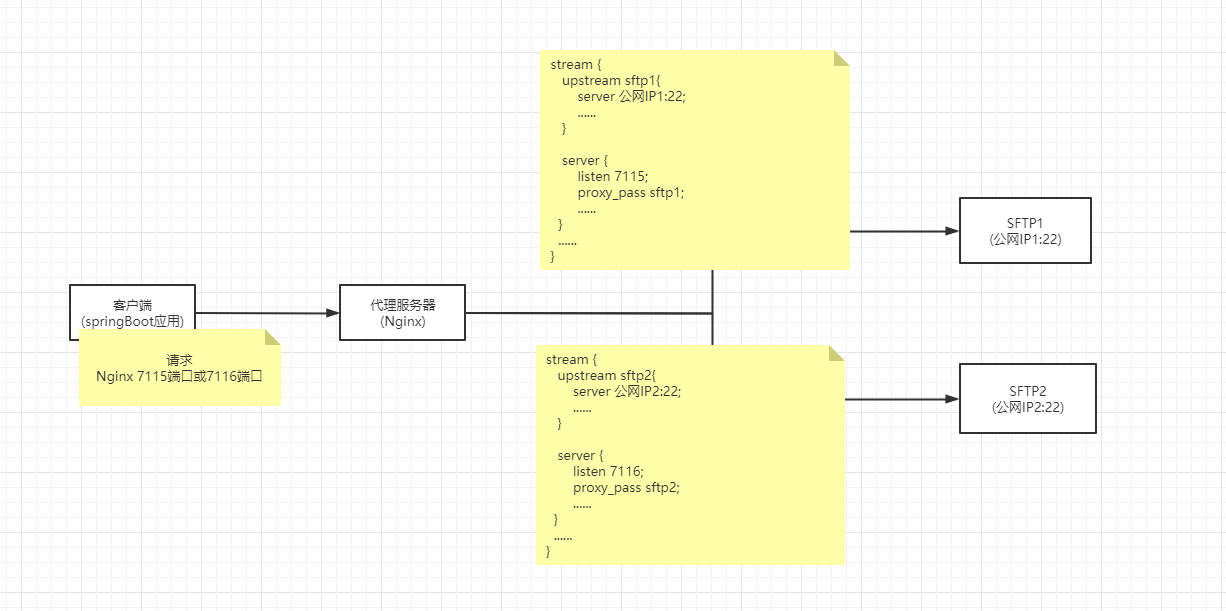【案例】Nginx代理Sftp服务器文件上传
架构

Sftp服务器
物理机
- 公网IP1:22
- 公网IP2:22
Nginx服务器
物理机
- 内网IP:80 (可访问外网)
代理sftp配置
text
stream {
upstream sftp1{
hash $remote_addr consistent;
server 公网IP1:22;
}
server {
listen 7115;
proxy_connect_timeout 300s;
proxy_timeout 300s;
proxy_pass sftp1;
}
upstream sftp2{
hash $remote_addr consistent;
server 公网IP2:22;
}
server {
listen 7116;
proxy_connect_timeout 300s;
proxy_timeout 300s;
proxy_pass sftp2;
}
}已安装Nginx情况下添加新的module
shell
# 源码目录
cd /usr/local/nginx/nginx-1.14.0
# 编译
./configure --prefix=/usr/local/nginx --with-stream
make
# 停止
/usr/local/nginx/sbin/nginx -s stop
# 备份原有nginx二进制文件
cp /usr/local/nginx/sbin/nginx /usr/local/nginx/sbin/nginx.20210818
# 复制新编译好的nginx二进制文件(此处nginx源码目录为。即为编译命令执行目录)
cp ./objs/nginx /usr/local/nginx/sbin/nginx
# 启动
/usr/local/nginx/sbin/nginx参考:
https://blog.csdn.net/zlxtk/article/details/80995955
https://blog.csdn.net/jijiuqiu6646/article/details/78675891
https://www.cnblogs.com/crysmile/p/9565048.html
Java代码
java
@Slf4j
@Service
public class ContentMediaSftpService {
@Value("${sftp.path.mediaPrefix:}")
private String pathMediaPrefix;
@Value("${sftp.path.mediaDirectory:media}")
private String pathMediaDirectory;
String upload(MultipartFile file, String fileName) {
boolean result = true;
SftpUtil sftpUtil1 = getSftp1();
SftpUtil sftpUtil2 = getSftp2();
// 生成临时文件
File tempFile = FileUtil.multipartFile2File(file, "/home/ms/attachment/temp");
try {
sftpUtil1.login();
sftpUtil1.uploadFile(pathMediaPrefix, pathMediaDirectory, fileName, tempFile);
sftpUtil1.logout();
} catch (Exception e) {
result = false;
log.error("sftp1文件上传失败", e);
}
if (!result) {
tempFile.delete();
return null;
}
try {
sftpUtil2.login();
sftpUtil2.uploadFile(pathMediaPrefix, pathMediaDirectory, fileName, tempFile);
sftpUtil2.logout();
} catch (Exception e) {
result = false;
log.error("sftp2文件上传失败", e);
}
tempFile.delete();
if (!result) {
return null;
}
return pathMediaPrefix + "/" + pathMediaDirectory + "/" + fileName;
}
public boolean delete(String directory, String deleteFileName) {
checkSftpConfig(ContentMediaErrorEnum.FILE_DELETE_ERROR);
SftpUtil sftpUtil1 = getSftp1();
SftpUtil sftpUtil2 = getSftp2();
/* SftpUtil sftpUtil1 = new SftpUtil("portal", "portal.0756", "172.30.21.56", 7115); // 172.30.22.143
SftpUtil sftpUtil2 = new SftpUtil("portal", "portal.0756", "172.30.21.56", 7116); // 172.30.22.167*/
boolean result1 = true;
boolean result2 = true;
try {
sftpUtil1.login();
sftpUtil1.delete(directory, deleteFileName);
sftpUtil1.logout();
} catch (Exception e) {
result1 = false;
log.error("sftp1文件删除失败", e);
}
try {
sftpUtil2.login();
sftpUtil2.delete(directory, deleteFileName);
sftpUtil2.logout();
} catch (Exception e) {
result2 = false;
log.error("sftp2文件删除失败", e);
}
ContentMediaErrorEnum.FILE_DELETE_ERROR.isFalse(result1 && result2);
return result1 && result2;
}
private SftpUtil getSftp1() {
return new SftpUtil("Sftp服务器1用户名", "Sfrp服务器1密码", "Nginx代理服务Ip", 7115);
}
private SftpUtil getSftp2() {
return new SftpUtil("Sftp服务器2用户名", "Sfrp服务器2密码", "Nginx代理服务Ip", 7116);
}
}java
public class FileUtil {
private FileUtil() {
}
public static File multipartFile2File(MultipartFile multipartFile, String basePathName) {
String fileType = getFileType(multipartFile.getOriginalFilename());
String pathName = generateFileFullName(basePathName, fileType);
File file = new File(pathName);
try {
FileUtils.copyInputStreamToFile(multipartFile.getInputStream(), file);
} catch (IOException e) {
throw new SystemException(e);
}
return file;
}
public static String getFileType(String fileName) {
return fileName.substring(fileName.lastIndexOf(".") + 1);
}
public static String generateFileFullName(String basePath, String fileType) {
String filePath = basePath + "/";
File file = new File(filePath);
if (!file.exists()) {
file.mkdirs();
}
String fileName = generateFileName(fileType);
return filePath + fileName;
}
public static String generateFileName(String fileType) {
StringBuilder fileNameBuilder = new StringBuilder();
if(!fileType.startsWith(".")) {
fileNameBuilder.append(UUID.randomUUID()).append(".").append(fileType);
}else {
fileNameBuilder.append(UUID.randomUUID()).append(fileType);
}
return fileNameBuilder.toString();
}
}java
@Slf4j
public class SftpUtil {
private ChannelSftp sftp;
private Session session;
/** SFTP 登录用户名 */
private String username;
/** SFTP 登录密码 */
private String password;
/** 私钥 */
private String privateKey;
/** SFTP 服务器地址IP地址 */
private String host;
/** SFTP 端口 */
private int port;
/**
* 构造基于密码认证的sftp对象
*/
public SftpUtil(String username, String password, String host, int port) {
this.username = username;
this.password = password;
this.host = host;
this.port = port;
}
/**
* 构造基于秘钥认证的sftp对象
*/
public SftpUtil(String username, String host, int port, String privateKey) {
this.username = username;
this.host = host;
this.port = port;
this.privateKey = privateKey;
}
public SftpUtil() {
}
/**
* 连接sftp服务器
*/
public void login() {
try {
JSch jsch = new JSch();
if (privateKey != null) {
// 设置私钥
jsch.addIdentity(privateKey);
}
session = jsch.getSession(username, host, port);
if (password != null) {
session.setPassword(password);
}
Properties config = new Properties();
config.put("StrictHostKeyChecking", "no");
session.setConfig(config);
session.connect();
Channel channel = session.openChannel("sftp");
channel.connect();
sftp = (ChannelSftp) channel;
} catch (JSchException e) {
log.error("=====sftp login error =====", e);
}
}
/**
* 关闭连接 server
*/
public void logout() {
if (sftp != null && sftp.isConnected()) {
sftp.disconnect();
}
if (session != null && session.isConnected()) {
session.disconnect();
}
}
/**
* 将输入流的数据上传到sftp作为文件。文件完整路径=basePath+directory
*
* @param basePath
* 服务器的基础路径
* @param directory
* 上传到该目录
* @param sftpFileName
* sftp端文件名
* @param input
* 输入流
*/
private void upload(String basePath, String directory, String sftpFileName, InputStream input) throws SftpException {
try {
sftp.cd(basePath);
sftp.cd(directory);
} catch (SftpException e) {
// 目录不存在,则创建文件夹
String[] dirs = directory.split("/");
StringBuilder tempPath = new StringBuilder();
tempPath.append(basePath);
for (String dir : dirs) {
if (null == dir || "".equals(dir)) {
continue;
}
tempPath.append("/").append(dir);
try {
sftp.cd(tempPath.toString());
} catch (SftpException ex) {
sftp.mkdir(tempPath.toString());
sftp.cd(tempPath.toString());
}
}
}
// 上传文件
sftp.put(input, sftpFileName);
}
/**
* 将件数据上传到sftp 文件完整路径=basePath+directory
*
* @param basePath
* 服务器的基础路径
* @param directory
* 上传到该目录
* @param sftpFileName
* sftp端文件名
* @param file
* 文件
*/
public void uploadFile(String basePath, String directory, String sftpFileName, File file) throws IOException,SftpException{
try(FileInputStream fileInputStream = new FileInputStream(file)){
upload(basePath, directory, sftpFileName, fileInputStream);
}
}
/**
* 删除文件
*
* @param directory
* 要删除文件所在目录
* @param deleteFile
* 要删除的文件
*/
public void delete(String directory, String deleteFile) throws SftpException {
sftp.cd(directory);
sftp.rm(deleteFile);
}
}